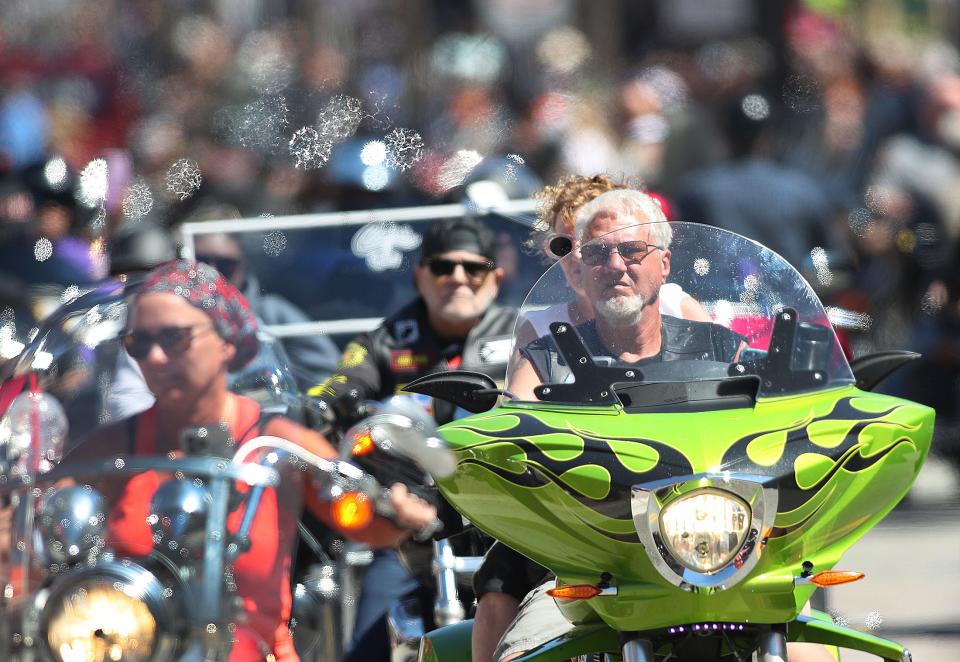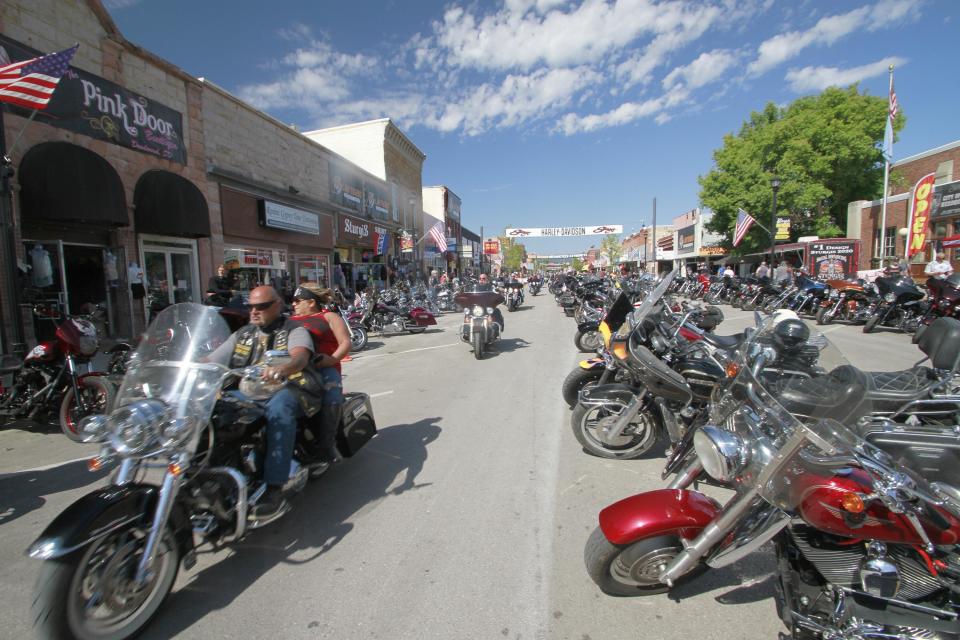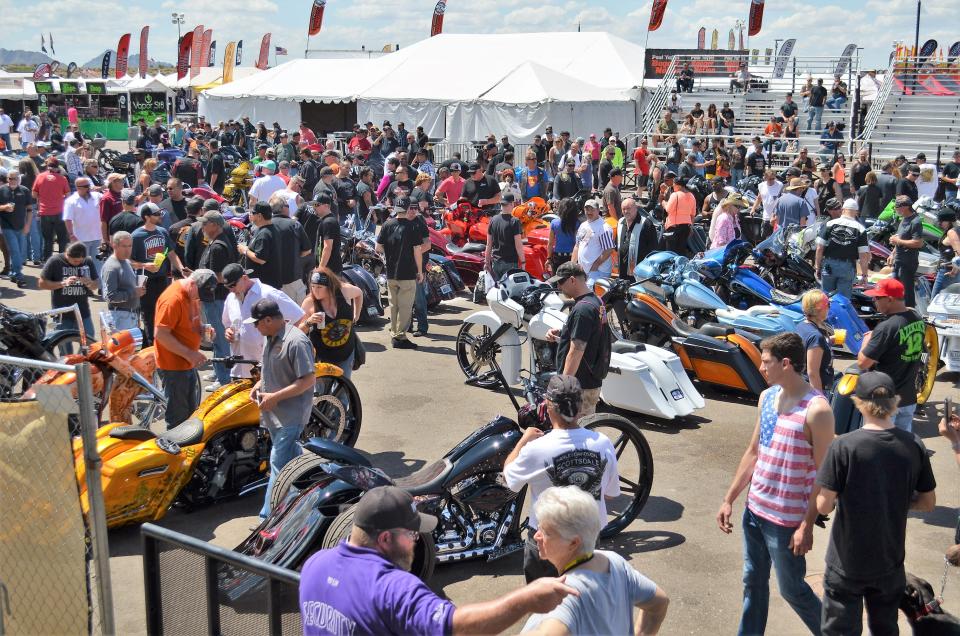How big are Daytona Bike Week crowds compared to other U.S. motorcycle rallies?
DAYTONA BEACH — It doesn’t take technology to see that Bike Week has arrived again at the World’s Most Famous Beach, where an armada of Harley-Davidsons and Hondas fill the streets, parking lots and campgrounds bearing license plates from nearly every corner of the nation.
The annual 10-day influx that runs through March 10 is estimated to attract 300,000-400,000 motorcycle fans to a region that stretches from the event’s epicenter in Daytona Beach throughout Volusia, Flagler, Brevard, Seminole, Orange, St. Johns and Duval counties, according to the event’s organizer, the Daytona Regional Chamber of Commerce.

It’s a ballpark estimate that has remained unchanged at least for a decade. Is it still accurate?
Even Chamber officials have their doubts.
“There hasn’t been a serious economic survey in over a decade, so anything we say is just going to be an estimate,” said Janet Kersey, executive vice president and chief operating officer of the Daytona Chamber, who has become one of the destination’s go-to authorities on Bike Week and its smaller-scale fall counterpart, Biketoberfest. “We may be way under, or way over.”
The current attendance figure is based on data that’s nearly two decades old, Kersey said.
At the time, it was calculated through a combination of county tourism bed tax collections as well as hotel occupancy and other economic indicators compiled by Evelyn Fine of Daytona Beach-based Mid-Florida Marketing & Research, a statistician of the destination’s tourism since the mid-1970s, Kersey said.
Because the event has become so geographically spread out, it's hard to make an accurate visitor count, Kersey said.
"Will we be right in the number that we put out when you consider how much the event has spread all across Florida?" she said. "A guy may stay in Orlando and spend a lot of money in Orlando and then ride over to Daytona Beach every day. Where does that count?"
A new arrival at Bike Week: Geofencing?
Now, there’s a chance that old estimate might someday be retired.
Amid the beer, bands and rumbling exhaust pipes of this year’s 83rd Annual Bike Week, the Chamber is considering the prospect of investing in new technology that could provide a more accurate picture of Bike Week’s attendance, demographics and economic impact, Kersey said.
The organization is exploring the cost and potential benefits of geofencing technology, a location-based service by which an app or other software program uses radio frequencies, Wi-Fi, GPS or cellular data to trigger a marketing action when a mobile device enters or exits a virtual geographic boundary.
It’s a research tool that already is being used for the first time at this year’s Bike Week by the City of Daytona Beach to provide an accurate count of visitors in various hot spots within city limits throughout the event, said Susan Cerbone, city spokeswoman.
The city paid $26,250 for a one-year service term with the analytics firm Placer.ai to calculate the number of Bike Week visitors in the areas surrounding Main Street, Daytona International Speedway and Dr. Mary McLeod Bethune Boulevard, Cerbone said.
History lesson: Daytona Beach's Bike Week: A history of beer, bikes, cole slaw and 'rowdyism'
Placer.ai uses “location intelligence” from cellphones to count visitors, provide “dwell time” in locations, where visitors go prior to coming to Daytona Beach and where they stop after leaving the city.
“We also have the city’s four bridges geofenced where Placer.ai can help calculate traffic counts,” Cerbone said. “While the technology won’t count every single person coming to Daytona Beach, it is a tool for us to be able to get an approximate number of attendees and their general travel patterns.”
Right now, the city doesn't have past Bike Week attendance figures, Cerbone said, but the new technology also could help with that.
"We don’t have numbers from previous years on hand, but the program allows us to go back and collect data from previous years and we plan to do that."
It’s the same analytics company that provides similar services to the organizers of the mammoth Sturgis Motorcycle Rally in South Dakota, among the major motorcycle rallies nationwide to embrace the cellphone technology.
It’s a trend that the Daytona Chamber is watching closely, Kersey said.
“We definitely are interested in it, the whole platform, how it works, what type of data it provides,” Kersey said. “If it’s something reasonable that we can do and it has value to it, we’re not opposed to it.”
Geofencing at Sturgis: ‘Amazing data’
In Sturgis, geofencing was used to track attendance for the first time this past summer at the iconic rally, touted as the world’s largest, said Deb Holland, communications director for the City of Sturgis.
Previously, officials estimated attendance by combining information from a variety of sources including traffic counters set up at nine entrances to the city; the amount of garbage collected during the event; an actual count of motorcycles and other vehicles in designated parking areas; and counts of people in photographs of the same site within Sturgis, taken several times daily.

Each of those methods had drawbacks in terms of accuracy, Holland said.
If it rained, for instance, garbage became heavier, affecting estimates based on its weight, she said. Traffic counters record vehicles, but not the potentially multiple occupants inside.
Attendance at the 2023 rally, based on the new technology, was more than 600,000, an increase over past estimates typically in the 400,000 to 500,000 range, Holland said. In addition, geofencing offered additional information that will bolster future marketing, she said.
“It’s definitely more expensive, but it’s also a marketing tool,” she said. “It’s giving us some demographic information, too. How old is that person? Where did they originate their journey to Sturgis? Where are they likely to go to dinner? It’s amazing data that we can use for marketing in the future.
“If we’re trying to reach a younger demographic and continue to thrive as a rally, we knew we had to employ the technology that’s out there.”
How do other major motorcycle events count crowds?
Laconia Motorcycle Week in New Hampshire, touted as the world’s oldest motorcycle rally, celebrated its 100th anniversary in 2023.
The 9-day rally that unfolds annually in June typically draws an estimated crowd of 300,000 motorcycle enthusiasts, said Jennifer Anderson, deputy director of the Laconia Motorcycle Week Association, the organization that presents the event.
Like Daytona’s Bike Week, there’s no formal method to arrive at that estimate, Anderson said. Instead, it’s calculated based on an assortment of information that includes traffic counts along with hotel occupancy and rates.
“The state does report out the statewide meals and rooms tax revenue, so we can make some estimates from that information, but again — it is not as specific as I would like it to be,” Anderson said by email.
Over the years, the association also has tried keep records of toll revenue collected by the State at Interstate 93 and State Route 16, the most common entry points to the Lakes Region where the event takes place.
“For lodging occupancy, we send out a survey to a large variety of facilities, including campgrounds, hotels/motels, private homes,” Anderson said. “That has been helpful for estimating attendance leading up to the rally. We also have a very close working relationship with our police and fire departments and public works.”
In addition, vending areas and entertainment tents at the event are permitted operations with capacity limits that offer a window into attendance, Anderson said. Likewise, crowds at the “Main Street” area of the event at Lakeside Avenue in Weirs Beach are estimated with assistance from police and fire department units at the event.
Like Daytona’s Bike Week, visitors to the event spread across a broad area statewide, Anderson said. That makes it harder to provide an accurate count.
“It is certainly the busiest in Laconia/Weirs Beach and our neighboring town of Meredith, but many people stay as far out as 60 miles away, like on the seacoast or in the White Mountains,” she said. “People stay throughout the entire state for the rally.”
In Arizona, geofencing part of 'super-accurate' numbers
By comparison, the footprint of the annual Arizona Bike Week, a five-day event in April that’s now in its 27th year in Scottsdale, Arizona, is much more compact.
“It’s a ticketed, gated event at WestWorld, a 400-acre event park in Scottsdale, so we know who comes every year and our numbers are super-accurate,” said Lisa Cyr, the event’s producer. “We’re really proud of our accurate numbers.”

Even so, Arizona Bike Week also has relied for the past five years on geofencing data provided through the City of Scottsdale to refine ticket-based attendance counts, Cyr said.
Based on that system, the 2023 edition of the event was attended by 62,000 unique visitors that contributed to a 95,000 total attendance figure that included those who went to the festival multiple days over its five-day run, Cyr said.
Geofencing counts have been more accurate that attendance figures based on ticket sales and gate counts at the event, Cyr said. Some ticket buyers ultimately don’t attend, she said, and with numerous gates on the grounds for concerts or other featured events, some attendees could be counted twice.
“Counting people with the geofencing is more accurate for us to know how many are on the property each day,” she said. “We don’t like to inflate the numbers. We want to keep it really honest and realistic, by really measuring how many people were actually there, not just how many tickets were sold.
“We want to do the count in the most accurate way possible because that’s the best way that we’ll be able to grow the festival.”
This article originally appeared on The Daytona Beach News-Journal: How Daytona Bike Week crowds compare with other biker rallies

